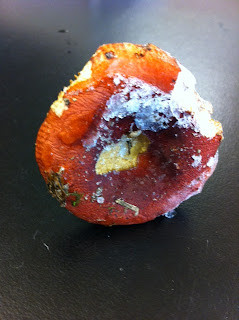 |
| Figure 1. Russula emetica. |
Name: Russula emetica
Common Name: The Sickener
Family: Russulaceae
Collection Date: September 13, 2011
Habitat: On wet, soggy dirt with some twigs scattered around. Underneath a large tree.
Location: South Chagrin Reservation in Chagrin Falls, Ohio
Description: Cap 3-10 cm broad, rounded-convex becoming plane or broadly depressed; surface viscid when moist, smooth, bright red to scarlet, the center often darker; fading in age or wet weather to pink, orange, or blotched with white; margin eventually striate (but sometimes obscurely). Flesh white (but pink under cuticle), brittle, odor mild, taste very acrid. Gills white or creamy-white, brittle, close, adnate to adnexed or free. Stalk 3-10 cm long, 0.7-2.5 cm thick, equal or thicker below, dry, white or whitish, usually with longitudinal lines.
Arora, D. (1979). Mushrooms Demystified. Berkeley, CA: Ten Speed Press.
Collector: Cara Tompot
Key Used: Arora, D. (1979). Mushrooms Demystified. Berkeley, CA: Ten Speed Press.
Keying Steps:
Key to the Major Groups of Fleshy Fungi
Basidiomycetes Pg 52.
Fruiting body with a cap and stalk, or just a cap; spores borne on gills (radiating blades) on underside of cap; spore print obtainable (if spores are being produced.) Agarics (Gilled Mushrooms), p. 58
Key to Agaricales:
1b. Not as above- (above: gills deformed or contorted or branched to form large cavities, sometimes never exposed; spores not forcibly discharged, hence spore print not obtainable; found mostly in deserts and mountains); spores forcibly discharged, hence spore print obtainable if spores are being produced; gills exposed at maturity; common and widespread.
2a. Spore print white to buff, yellow, yellow-orange, or lilac-tinged.
3b. Neither volva nor warts present (but cap and stalk may have scales or fibrils.)
4b. Not as above- (above: gills typically free and veil present; veil usually forming an annulus (ring) on stalk, or if not then stalk typically scaly or slimy below the veil); veil absent, or if present then gills normally attached to stalk.
6b. Not as above- (above: gills decurrent and foldlike (at least when young), i.e., gills thick, blunt, shallow, and usually forked or with cross-veins); gills usually platelike or bladelike.
7b. Not as above- (above: gills and/or flesh exuding a latex (milk or juice) when broken; stalk typically more than 3 mm think; spores with amyloid warts or ridges.
8a. Fruiting body brittle and rather rigid, the stalk snapping open cleanly like a piece of chalk (i.e., without fibrous context); cap usually plane to depressed at maturity; stalk typically at least 3 mm thick; veil absent; usually but not always terrestrial; cap and stalk tissue typically containing nests of sphaerocysts; spores with amyloid warts of ridges. Russulaceae, p. 63.
Key to Russulaceae:
1b. Latex absent. Russula, p. 83.
Key to Russula:
1b. Not with above combination of characteristics- (above: fruiting body medium to very large, hard; cap white to brown, black, or grayish (never brightly colored); gills typically adnate to decurrent and usually alternating long and short; cap cuticle not peeling easily, margin not striate.)
10b. Not as above- (above: fruiting body very firm and stalk hard; cap whitish becoming ochre, rusty-brown, or reddish-brown, margin not striate; all parts bruising or discoloring ochraceous to cinnamon-brown; odor often unpleasant in age, never sweet; spore print white; common in eastern North America.)
11b. Not as above- (above: odor heavy and sweet, but in age often becoming fetid; cap medium-sized to large, yellow- brown to straw-color, dull ochre, or yellow-orange.)
12b. Not as above-(above: cap 5-12cm broad, typically dark res with nearly blackish center; taste usually acrid but sometimes mild; spore print whitish; common under hardwoods in eastern North America.)
13b. Not as above- (above: flesh and stalk surface staining gray to ashy or black (sometimes slowly and sometimes with an intermediate reddish phase.)
17b. Not as above- (above: cap bright yellow to golden-yellow; mature gills yellowish.)
18b. Cap some other color (including yellow-brown) when fresh, but may fade to whitish in age.
23a. Taste of flesh and/or gills distinctly acrid (taste them both!)
24a. Stalk white (but sometimes with stains or discolorations, especially at base.)
25b. Not as above- (above: cap yellow-brown to dull straw-color, hazel-brown, grayish-brown, or even darker at center; margin striate and with small bumps, at least in age; odor usually rather unpleasant; very common.)
26a. Spore print and gills white or whitish.
27b. Not as above- (above: stalk and flesh often staining orange or pink when bruised; cap typically multicolored.)
28b. Not as above- (above: cap red suffused with gray or brown; associated with western conifers and especially common in the Rocky Mountains) but cap may be red.
29a. Cap bright red when fresh, but often fading to pink, orange, or sometimes even white. Russula emetica, p. 97.
 |
| Figure 2. Russula emetica. Note the fading color of the cap and the large white chunks with a lack of mucus. |
 |
| Figure 3. Russula emetica. Note the reddish tinge to the aged and bruised stalk. |
No comments:
Post a Comment